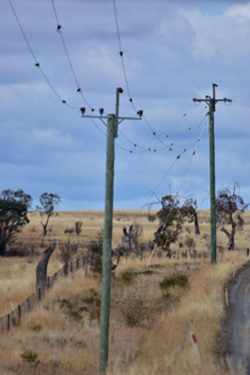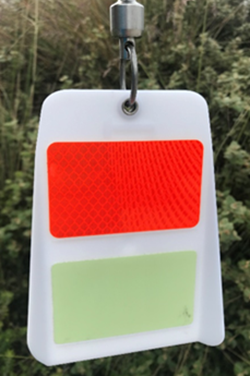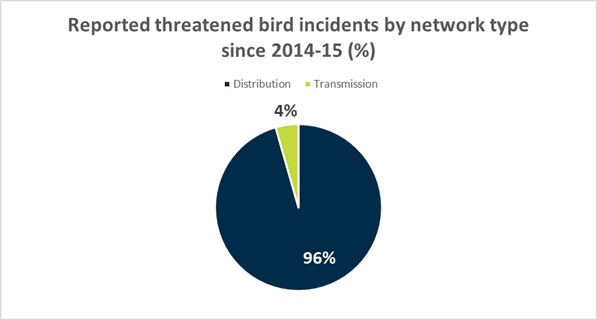Protecting birdlife
TasNetworks cares about the environment and our iconic Tasmanian wildlife. That’s why we’re working hard to minimise risks that our poles and wires pose to birds of prey, such as Wedge-tailed Eagles, Grey Goshawks and White-bellied Sea Eagles. We're also working closely with our partners to support broader protection and conservation outcomes for birds of prey of in Tasmania. Read more about these partnerships.
Each year a number of birds of prey are injured or electrocuted when they fly into power lines or perch on power poles near live electrical equipment. However, because our lines are often in remote hard to reach places, we don’t know the true extent of the problem.
-
How do I report a bird injury or death?
If you find a bird of prey which has been injured or killed near our powerlines, please report it to us on 132 004 or complete our Wildlife Incident form as soon as possible.
The more we understand about where and how incidents occur, the better equipped we are to make decisions about how we protect birds into the future.
-
How is TasNetworks responding?
We're taking a proactive, strategic approach to reducing the impact of the electricity network by implementing our Threatened Bird Strategy. The aim of the strategy is a material reduction in TasNetworks’ impact on threatened Tasmanian birds.
We have made great progress implementing our Threatened Bird Strategy. Over 60km of bird mitigation was installed in 2018-19 and another 180km of lines will be mitigated over the next 3 years. Areas of focus so far have been Gladstone, Epping Forrest and Oatlands-Lemont.
-
What is bird mitigation?
Bird mitigation is any measure which makes our poles and wires safer for birds. This includes installing bird flappers, perches and conductor covers.
We apply a risk-based approach, using our Eagle Strike-Risk Model to prioritise the installation of bird mitigation. This approach ensures that we maximise the overall reduction in risk to birds of prey, particularly threatened birds, state-wide per dollar spent.Our Eagle Strike Risk Model has been developed by analysing historic incident data and seeking expert opinion.
-
What are bird perches and bird flappers?
Birds of prey can receive electric shocks while perching on the top of our distribution poles. To stop this, we install perches that keep birds away from the live parts of the pole top by giving them a higher place to perch.
These devices aren’t pretty but by making our power lines more visible, they are helping to keep birds safe.
Another mitigation device known as a bird flappers are installed to powerlines to make them more visible to birds so they're more likely to avoid flying into them.
Flappers are rectangular plastic discs that attach to powerlines and swivel in the wind. They contain glow-in-the-dark crystals, which absorb and emit purple ultraviolet light and make them visible to birds during both day and night, but appear as white to us.


-
What listed threatened species are most impacted?
The bird species most impacted by our poles and wires are large birds of prey, specifically The Tasmanian Wedge-tailed Eagle, White-bellied Sea Eagle and Grey Goshawk.
Video: How to identify birds of prey with Nature Trackers.
Other known incidents include a Masked Owl and a Shy Albatross. Non-listed species of birds can also be impacted however these species are not currently the focus of our Threatened Bird Strategy.
-
Where does most of the impact occur?
Our research tells us that overhead distribution powerlines situated in flat, open areas away from a nesting habitat (greater than 2km) but near a prey source like a lake or a river, are high-risk for Wedge-tailed Eagle collisions.
The hot-spots for Wedge-tailed Eagle collisions include:- Agricultural areas of the upper and lower Midlands;
- The Derwent Valley
- Agricultural areas on North-East and East Coast and;
- Agricultural areas of the inland North-West.
Bird of prey species such as White bellied Sea Eagles and Grey Goshawks are more likely to be electrocuted when using our distribution power poles for perching. Our historic incident data indicates that power poles near areas of high prey and food availability are higher risk. In contrast to Wedge-tailed Eagles and White-bellied Sea Eagles, Grey Goshawks are often impacted in more populated areas.
-
Does the transmission network pose a risk to threatened birds?
Statistics indicate that our transmission network poses a significantly lower risk to threatened birds when compared to our distribution network. Over the last six years, only 4% of the reported threatened bird incidents have involved transmission infrastructure.
This is because:- The transmission network uses larger wires, which are easier for large birds of prey to see and avoid than the thinner wires used on the distribution network.
- The distance between conductors and tower structures on the transmission network are generally greater than a full-grown adult Wedge-tailed Eagle’s wing-span of 2.3m, which means there’s less chance of electrocution for birds of prey. This distance is much larger than the distance between conductors on the distribution network.

TasNetworks’ transmission network transmits bulk electricity over long distances, from large generators to Tasmania’s population centres and industrial zones. The transmission network is made up of large steel towers and conductors. The distribution network distributes power to residential customers and businesses. It is made up of wooden poles and thin conductors.
-
What else is TasNetworks doing to make the electricity network safer for large birds of prey?
As we build and carry our repairs and upgrades on the electricity network, we'll incorporate new designs and components that will help to make our distribution overhead power lines progressively safer for Tasmanian birdlife. While making these changes will take time, we have done so based on the best available evidence and on the learnings of other electricity infrastructure businesses globally.
The key changes we are making to our overhead distribution assets includes:
Fiberglass cross-arms
Fiberglass cross arms are non-conductive conductor (wire) supports that will be used instead of the current steel cross-arms for all new high-voltage power lines. The use of a non-conductive material, together with increased conductor spacing, will significantly reduce the risk of pole-top electrocutions for birds.
Image courtesy of David Waters: Grey Goshawks perching on a low voltage cross-armDelta conductors
Underslung conductors
75% of reported electrocutions of large birds of prey occur when they contact two or more conductors ‘mid-span’ (the conductors in-between two successive power poles). Replacing our current flat conductor alignment with a triangle or ‘delta’ configuration minimises the risk of electrocution by reducing the chance of large birds of prey touching two conductors simultaneously.
When completing new constructions or replacement work, we will be installing underslung conductors wherever possible. Underslung conductors on strain poles reduce the risk of pole-top electrocutions.
-
How can I help make a difference?
 To help the Tasmanian wedge-tailed eagle, we need to know how many there are, and how their populations are doing. Scientists are researching these endangered birds, and their research helps guide our threatened bird mitigation program.
To help the Tasmanian wedge-tailed eagle, we need to know how many there are, and how their populations are doing. Scientists are researching these endangered birds, and their research helps guide our threatened bird mitigation program.You can help by getting involved in citizen science with the NatureTrackers program, Where? Where? Wedgie!
The Where? Where? Wedgie! surveys run every year in May. If you're in Tasmania at that time, you can take part.
Find out more about the Where? Where? Wedgie! project.
.

Contact us
Have any questions? Let us know. Email TasNetworks Environment and Sustainability Team at Environment@tasnetworks.com.au or submit an online enquiry.

